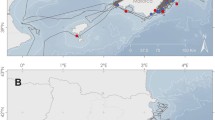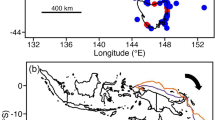Abstract
The fishhook waterflea Cercopagis pengoi was first reported in Lake Ontario in 1998, but subsequently spread to Lakes Michigan and Erie as well as some inland lakes. One possible mechanism of dispersal to inland lakes occurs via fouling of and subsequent transfer on sport fishing lines. Here we explore fouling of Cercopagis on different commercial brands of fishing lines while trolling on Lake Ontario. Accumulation of animals varied significantly across brands, and was lowest on Flea Flicker brand. Fouling was more intense with line set at 20 than at 10 m, and was directly related to the distance trolled. Different pound-tests of Flea Flicker did not vary significantly in Cercopagis accumulation rates. The maximum number of Cercopagis and diapausing stages on a fishing line was 1024 individuals and 106 diapausing eggs. Because diapausing eggs may remain viable for weeks or longer, their transfer on fouled fishing line to non-invaded lakes poses a risk of invasion and supports previous studies that suggested sport fishermen as possible vectors of dispersal of invasive waterfleas.



Similar content being viewed by others
References
Benoit, H. P., O. E. Johannsson, D. M. Warner, W. G. Sprules & L. G. Rudstam, 2002. Assessing the impact of a recent predatory invader: the population dynamics, vertical distribution, and potential prey of Cercopagis pengoi in Lake Ontario. Limnology and Oceanography 47: 626–635.
Branstrator, D. K., L. J. Shannon & M. E. Brown, 2005. Effects of physical and chemical stressors on survival of the diapausing egg of Bythotrephes longimanus. American Society of Limnology and Oceanography February 2005 Conference, Salt Lake City.
Charlebois, P. M., M. J. Raffenberg & J. M. Dettmers, 2001. First occurrence of Cercopagis pengoi in Lake Michigan. Journal of Great Lakes Research 27: 258–261.
Drake, J. M, 2004. Allee effects and the risk of biological invasion. Risk Analysis 24: 795–802.
Green, A. J. & J. Figuerola, 2005. Recent advances in the study of long-distance dispersal of aquatic invertebrates via birds. Diversity and Distributions 11: 49–156.
Jarnagin, S. T., W. C. Kerfoot & B. K. Swan, 2004. Zooplankton life cycles: direct documentation of pelagic births and deaths relative to diapausing egg production. Limnology and Oceanography 49: 1317–1332.
Ketelaars, H. A. M., A. J. Wagenvoort, R. F. Herbst, P. A. W. van der Salm & G. J. de Jonge-Pinkster, 1995. Life history characteristics and distribution of Bythotrephes longimanus Leydig (Crustacea, Onychopoda) in the Biesbosch reservoirs. Hydrobiologia 307: 239–251.
Krylov, P. I., D. E. Bychenkov, V. E. Panov, N. V. Rodionova & I. V. Telesh, 1999. Distribution and seasonal dynamics of the Ponto-Caspian invader Cercopagis pengoi (Crustacea, Cladocera) in the Neva Estuary (Gulf of Finland). Hydrobiologia 393: 227–232.
Laxon, C. L., K. N. McPhedran, J. C. Makarewicz, I. V. Telesh & H. J. MacIsaac, 2003. Effects of the nonindigenous cladoceran Cercopagis pengoi on the lower food web of Lake Ontario. Freshwater Biology 48: 2094–2106.
Leung, B., J. M. Drake & D. M. Lodge, 2004. Predicting invasions: propagule pressure and the gravity of Allee effects. Ecology 85: 1651–1660.
Lockwood, J. L., P. Cassey & T. M Blackburn, 2005. The role of propagule pressure in explaining species invasion. Trends in Ecology and Evolution 20: 223–228.
MacIsaac, H. J., I. A. Grigorovich, J. A. Hoyle, N. D. Yan & V. E. Panov, 1999. Invasion of Lake Ontario by the Ponto-Caspian predatory cladoceran Cercopagis pengoi. Canadian Journal of Fisheries and Aquatic Sciences 56: 1–5.
MacIsaac, H. J., J. Borbely, J. Muirhead & P. Graniero, 2004. Backcasting and forecasting biological invasions of inland lakes. Ecological Applications 14: 773–783.
Makarewicz, J. C., I. A. Grigorovich, E. L. Mills, E. Damaske, M. E. Cristescu, W. Pearsall, M. J. LaVoie, R. Keats, L. Rudstam, P. D. N. Hebert, H. Halbritter, T. Kelly, C. Matkovich & H. J. MacIsaac, 2001. Distribution, fecundity, and genetics of Cercopagis pengoi in Lake Ontario. Journal of Great Lakes Research 27: 19–32.
Muirhead, J. R. & H. J. MacIsaac, 2005. Development of inland lakes as hubs in an invasion network. Journal of Applied Ecology 42: 80–90.
Ojaveer, H., L. A. Kuhns, R. P. Barbiero & M. L. Tuchman, 2001. Distribution and population characteristics of Cercopagis pengoi in Lake Ontario. Journal of Great Lakes Research 27: 10–18.
Ojaveer, H., M. Simm & A. Lankov, 2004. Population characteristics and ecological impact of the non-indigenous Cercopagis pengoi in the Gulf of Riga (Baltic Sea). Hydrobiologia 522: 261–269.
Ricciardi, A., 2006. Patterns of invasion in the Laurentian Great Lakes in relation to changes in vector activity. Diversity and Distributions 12: 425–433.
Acknowledgements
We are grateful for comments from Drs. L.-M. Herborg, Sarah Bailey and Donn Branstrator, and field assistance from Colin van Overdijk, Sandra Ellis and Jim Muirhead. We acknowledge financial support from the Department of Fisheries and Oceans, NSERC, and Ontario Ministry of Natural Resources. This study received no support or compensation from, nor does it endorse, any of the products tested.
Author information
Authors and Affiliations
Corresponding author
Additional information
Handling editor: S. Dodson
Rights and permissions
About this article
Cite this article
Jacobs, M.J., MacIsaac, H.J. Fouling of fishing line by the waterflea Cercopagis pengoi: a mechanism of human-mediated dispersal of zooplankton?. Hydrobiologia 583, 119–126 (2007). https://doi.org/10.1007/s10750-006-0487-3
Received:
Revised:
Accepted:
Published:
Issue Date:
DOI: https://doi.org/10.1007/s10750-006-0487-3




